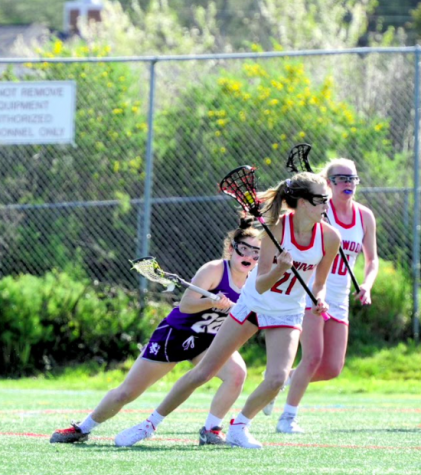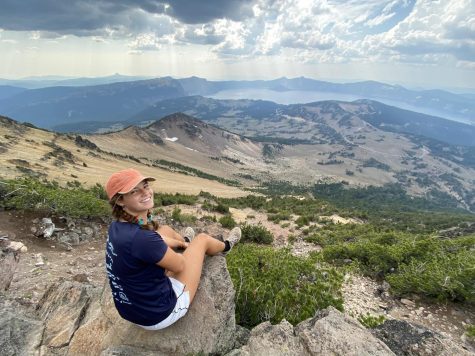COVID-19 restrictions change the recruiting game plan
October 25, 2020
Every athlete longs for the pre-pandemic days when practices, competitions and tournaments were a familiar routine. While college recruiting was always stressful, athletes striving to compete beyond high school usually had a rough idea about the process. COVID-19 has upended the norms for recruiting in most sports and, therefore, upended many student-athletes’ plans.

Since March, thousands of tournaments, races and games essential to the college recruiting process have been canceled, making it difficult for athletes to get exposed to different college coaches, especially in team sports since they rely on the combinations of players’ unique skills.
Junior Harper Glass, who is hoping to get recruited for Division I lacrosse, has found it difficult to get noticed during the pandemic. Glass believes that athletes from areas with fewer COVID-19 restrictions, such as many counties on the East Coast, have an advantage in the recruiting process. East Coast players have been able to film their matches and send updated highlight reels to college coaches, whereas California athletes are still unable to practice in full capacity and are limited to playing in pods of 12. Additionally, new nationwide National Collegiate Athletic Association (NCAA) rules for girls’ lacrosse, as well as other sports with earlier recruiting timelines, have prohibited all in-person communication between college coaches and potential recruits graduating in 2022 or later until Jan. 1, 2021.
“The coaches are really looking to grab the people who they have seen and commit them to a team before they actually get the chance to see everyone else, which sucks because now they can’t see us for three more months,” Glass said.

Even athletes in less subjective sports such as track and field, swimming and golf that rely more on statistics and times have also been affected. Many are struggling to send in updated results, though they are less likely to fall behind in the recruiting process compared to their competitors across the country. Senior Hudson Grace is in the midst of his recruiting process for both cross country and track and field, and though he acknowledges that there are disadvantages caused by the pandemic, he admits that it may not be as drastic as other sports since he has been able to race in unofficial time-trials to update coaches on his current times.
“A lot of [runners] have a lot of potential, but haven’t reached that potential because they haven’t been able to race,” Grace said. “Because they don’t have the times they could have gotten during the season, their recruiting may have been impacted.”

On the opposite side of the process, college coaches have faced equally challenging deterrents, such as finding the finances to support college seniors already on the team who are eligible for an additional scholarship year due to canceled seasons. According to Kelly Coffey, the head women’s soccer coach at Dominican University, returning seniors could affect the financial scholarships normally reserved for incoming freshmen for years to come, especially in sports with less funding. This could change how coaches choose their future rosters. However, the highly televised sports such as Division I men’s basketball and football are less likely to run into this issue. Admissions are more willing to cover the cost of the extra scholarships awarded to fifth-year players in these sports because they generate larger revenues for the schools.
Along with navigating these new financial challenges, Coffey admits that the pandemic has been especially difficult for women’s sports such as lacrosse and soccer since they usually have larger rosters and accelerated recruiting processes. Without being able to attend tournaments and hold camps, college coaches are now relying on film and communication with players.
“The two biggest [issues we have] are the inability to evaluate players and have them on campus. It has really forced us to be creative with some of the things that we do. We have Zoom recruiting trips. As a department, we’ve created a virtual athletics based video that we send out to athletes so they can tour the athletic complex and the rest of campus,” Coffey said.
Although there are downsides to the new recruiting process, Coffey understands that coaches have gotten to know their potential recruits’ personalities better through Zoom meetings and phone calls than they normally would have.
Glass too has taken a positive outlook on these unexpected circumstances. While she wishes she could have had a normal season, she is appreciative of certain aspects of this new process.
“[Recruiting happens] so fast when they are able to see us play, so it lets me think about what the right decision is for me and what I really want to do for the next four years,” Glass said. “Honestly, it is unfortunate that everything happened, but in hindsight, it’s kind of better that it has slowed down a lot.”
Grace has also adjusted to the new process and shares his optimism for the future, reminding others that no matter the outcome, the process will have been worth it.
“The worst possible outcome is that someone doesn’t get recruited who could have,” Grace said. “That is unfortunate, but if you are academically strong as well, I think that you are going to be able to do well throughout college and throughout life anyway.”







